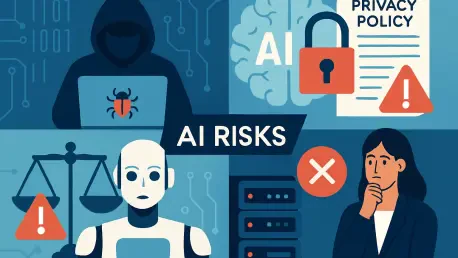As artificial intelligence (AI) continues to penetrate every corner of the technology sector in 2025, IT leaders are grappling with a staggering statistic: over 50% of global organizations are projected to implement AI-free skills assessments by next year to counter the erosion of critical thinking. This alarming trend, highlighted in recent industry forecasts, underscores the dual nature of AI as both a catalyst for innovation and a harbinger of significant risks. The purpose of this market analysis is to dissect the latest predictions surrounding AI’s trajectory, focusing on the challenges and opportunities it presents for IT enterprises. By examining current trends and future projections, this discussion aims to equip decision-makers with the insights needed to navigate a rapidly evolving landscape where technological advancement meets unprecedented uncertainty.
Diving Deep into AI Market Trends and Projections
The Dual Nature of AI: Innovation Meets Risk
The AI market in 2025 is characterized by an intricate balance between groundbreaking potential and inherent dangers. Generative AI (GenAI) has emerged as a transformative force, driving efficiency in sectors ranging from customer service to financial operations. However, this rapid adoption comes with substantial risks, including safety failures and regulatory complexities. Industry forecasts indicate that by 2027, AI-driven disruptions will reshape a $58 billion productivity tool market, prioritizing speed over legacy compatibility and opening doors for new entrants. IT leaders must weigh these opportunities against the darker implications, as overlooking behavioral and societal impacts could lead to operational setbacks.
Critical Thinking Under Threat in AI-Dominated Workforces
A pressing concern within the current market is the erosion of critical thinking skills due to over-reliance on GenAI tools. Predictions suggest that by 2026, half of global organizations will adopt assessments devoid of AI assistance to ensure employees retain independent problem-solving abilities. This trend is particularly critical in high-stakes industries like healthcare and finance, where diminished analytical skills could result in costly errors. The rising demand for talent capable of human reasoning is expected to inflate acquisition costs, pushing companies to innovate hiring strategies and develop specialized evaluation methods to address this cognitive challenge.
Safety Failures and Legal Challenges Loom Large
Safety failures in AI applications represent another significant risk factor impacting market dynamics. Forecasts warn that by the end of 2026, legal claims related to “death by AI” in sectors such as autonomous vehicles and medical systems could exceed 1,000 globally, driven by inadequate risk guardrails. This projection signals a growing need for transparency and accountability in AI deployments. Organizations face the dual challenge of mitigating litigation risks while maintaining consumer trust, with some likely to differentiate themselves by limiting AI use in sensitive areas, while others invest heavily in robust safety protocols to navigate this turbulent terrain.
Fragmentation of AI Platforms Across Global Markets
The global AI landscape is becoming increasingly fragmented, with projections indicating that by 2027, 35% of countries will adopt region-specific platforms tailored to local regulations, languages, and cultural contexts. This shift poses a formidable challenge for multinational corporations, which must manage diverse partnerships and comply with varying data governance frameworks. Unlike earlier expectations of universal AI solutions, this trend reflects geopolitical and cultural divides, compelling IT leaders to adopt adaptive strategies. Failure to address these regional disparities could result in compliance issues and hinder operational efficiency in a highly competitive market.
Transformative Potential Reshaping IT Operations
Despite the risks, AI’s transformative potential continues to drive market evolution. By 2028, multiagent AI is expected to dominate customer interactions, with 80% of engagements leveraging this technology to meet demands for seamless service. Additionally, AI-intermediated business-to-business transactions are projected to generate over $15 trillion in spending, fostering a data-feed economy where trust frameworks become essential. Looking further ahead to 2030, programmable financial transactions using stablecoins and tokenized assets are anticipated to empower AI agents with economic agency, signaling a profound shift in how enterprises approach monetary exchanges.
Regulatory Complexities and Compliance Investments
Regulatory fragmentation adds another layer of complexity to the AI market, with forecasts suggesting that by 2027, fragmented laws will cover half of global economies, necessitating $5 billion in compliance investments. The absence of a unified definition for AI exacerbates governance challenges, as organizations struggle to align with diverse legal expectations. This trend underscores the importance of dedicated AI governance programs, supported by specialized software and personnel, to manage risks independently of traditional security measures. Navigating this regulatory maze will be crucial for maintaining a competitive edge in an increasingly scrutinized environment.
Reflecting on AI’s Market Implications and Strategic Pathways
Looking back on this analysis, it becomes evident that AI’s influence on IT markets in 2025 is marked by both unparalleled opportunities and significant challenges. The erosion of critical thinking, safety failures, and regulatory fragmentation emerge as pivotal risks that demand proactive mitigation. Meanwhile, AI’s potential to revolutionize productivity tools, customer interactions, and financial systems offers a glimpse into a future of enhanced efficiency and innovation. For IT leaders, the path forward involves embracing strategic foresight by integrating AI-free assessments to preserve human judgment, investing in transparent safety mechanisms to avert legal repercussions, and adopting localized strategies to tackle regional disparities. Establishing robust governance frameworks also proves essential to balance compliance with market competitiveness, ensuring that AI serves as a catalyst for progress rather than a source of peril in the evolving technological landscape.









